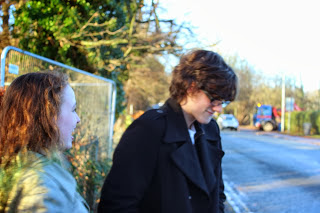All the following photos were taken to improve on previous bad photos. I chose these photos as improved photos as they were laid out better and made better use of the rule of three and had much better lighting and contrast levels etc.
This photo improved on the previous one taken because previously the photo was mislaid and did not show any perspective to what was behind it. Furthermore the photo was lacking exact details that could give clues to the plot of the story. Perspective was included in this photo which gave some of the narrative away to the viewer. Also the photo made good use of balancing which meant that the content on the image was not biased to one side.
This photo improved on the previous one because previously the photo took up the entirety of the screen, this meant we as the view had no idea of the perspective or narrative behind the image. The image is improved because there is perspective to it and a clear use of the rule of three.
The improvement image is unique because we completely changed the whole idea of the original image. Originally this image was face on and just included the whole of the characters face close up. In this image we have positioned the character to the side. We made this decision because it now looks as though she is looking on to something, furthermore this adds to the other all diversity and narrative of the image.
This image was originally laid out to have the main character in the centre of the image. Slightly zoomed out and a hazed perspective on it. We improved on that by moving the character to one side and creating a more bold expressive look on the character face. This shows use of spacing and the rule of three. It also shows simplicity within the image.
This image originally was laid out shockingly. It was the only portrait image in all of our photos and it was the only out of focus image in all of our photos. We improved on that original by once again re thinking the layout of the image. This meant analysing the scene for the most best positioning of the character. We also changed the expression on the characters face as well as using the rule of three to show background content in the image.
This was the last image that we improved on and we did so by improving layout, look and how we conveyed the narrative. The narrative is clear in this improved image by the clear look on the characters face. It also shows a clear use of the rule of three, which was an improvement on the original image, furthermore the background of the image is slightly blurred which not only adds to the narrative it adds to the overall diversity of the image.































